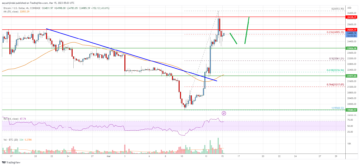
Ethereum developers are working to take their digital baby to the next level. They’re now establishing something called “distributed validator technology” or DVT.
Ethereum Continues Its Trek Forward
Right now, there are more than 600,000 Ethereum validators in the world. The problem is they are too independent of each other, so what one might see as a successful pushing of transactions forward, another might see as a failure. Also, these validators are still prone to several financial penalties known as “slashing.” This can occur whenever validators go offline for extended periods.
The idea is to ensure validators become decentralized and work in a fully decentralized environment. To do this, developers are making it so that private keys – usually only associated with separate or individual validators – can be split amongst all validators. They can be used to sign in by multiple people, thus allowing validators’ data to be shared across clusters of node operators.
Steven Quinn – the head of research at the staking service provider P2P – explained in an interview:
From a technical perspective, what [this] means is you can geographically distribute the machines.
To aid in the deployment of these distributed validators, Ethereum is employing the assistance of two open-source networks. The first is Obol; the second is SSV. The goal is to have two minds regularly agreeing with each other, so success somewhere cannot be seen as failure in another region.
Obol documents read:
Should <33 percent of the participating nodes in a DV cluster go offline, the remaining active nodes can still come to consensus on what to sign and can produce valid signatures for their staking duties.
Regarding DVT, Messari research analyst Stephanie Dunbar explained:
What I’m most excited about is the idea of increasing resiliency on Ethereum and in the future, potentially on other blockchains as well.
Ethereum has come quite a long way over just the last few months. While it was hyped long before it officially occurred, the Merge update – which took place in September of last year – was one of the final building blocks in establishing the world’s second largest digital currency by market cap as a proof of stake rather than a proof of work module.
The idea was to ensure Ethereum could continue running and garnering more developer attention by enforcing quicker transaction times and thinner gas fees. From there came the Shapella upgrade, which occurred just a few months ago in April of 2023.
Withstanding All That’s Thrown at It
Walter Smith of the technology firm Galaxy mentioned that the importance of DVT revolves around making the ETH blockchain more “resilient,” and that the network should be able to withstand whatever “external or internal disturbances” it faces. He commented:
This can be from geopolitics, regulation, markets, or even less intuitive disruptions like fires or earthquakes.
- SEO Powered Content & PR Distribution. Get Amplified Today.
- PlatoData.Network Vertical Generative Ai. Empower Yourself. Access Here.
- PlatoAiStream. Web3 Intelligence. Knowledge Amplified. Access Here.
- PlatoESG. Automotive / EVs, Carbon, CleanTech, Energy, Environment, Solar, Waste Management. Access Here.
- BlockOffsets. Modernizing Environmental Offset Ownership. Access Here.
- Source: https://www.livebitcoinnews.com/ethereum-seeks-to-employ-new-trend-called-distributed-validator-technology/
- :has
- :is
- 000
- 2023
- 33
- 7
- 8
- 9
- a
- Able
- About
- across
- active
- ago
- agreeing
- Aid
- All
- Allowing
- also
- amongst
- an
- analyst
- and
- Another
- April
- ARE
- around
- AS
- Assistance
- associated
- At
- attention
- BE
- become
- before
- Bitcoin
- Bitcoin News
- blockchain
- blockchains
- Blocks
- Building
- by
- called
- came
- CAN
- cannot
- cap
- Cluster
- come
- commented
- Consensus
- continue
- continues
- could
- Currency
- data
- decentralized
- deployment
- Developer
- developers
- digital
- digital currency
- disruptions
- distribute
- distributed
- do
- documents
- each
- enforcing
- ensure
- Environment
- establishing
- ETH
- eth blockchain
- ethereum
- Even
- excited
- explained
- faces
- Failure
- Fees
- few
- final
- financial
- fires
- Firm
- First
- For
- Forward
- from
- fully
- future
- Galaxy
- GAS
- gas fees
- Geopolitics
- Go
- goal
- Have
- he
- head
- HTTPS
- hyped
- idea
- importance
- in
- increasing
- independent
- individual
- internal
- Interview
- intuitive
- IT
- ITS
- jpg
- just
- keys
- known
- largest
- Last
- Last Year
- less
- Level
- like
- live
- Live Bitcoin News
- Long
- Machines
- Making
- Market
- Market Cap
- Markets
- means
- mentioned
- Messari
- might
- minds
- module
- months
- more
- most
- multiple
- network
- networks
- New
- news
- next
- node
- Node Operators
- nodes
- now
- occur
- occurred
- of
- Officially
- offline
- on
- ONE
- only
- open source
- operators
- or
- Other
- over
- p2p
- participating
- People
- percent
- periods
- perspective
- Place
- plato
- Plato Data Intelligence
- PlatoData
- potentially
- private
- Private Keys
- Problem
- produce
- proof
- Proof-of-Stake
- provider
- Pushing
- quicker
- rather
- Read
- region
- regularly
- Regulation
- remaining
- research
- revolves
- running
- Second
- see
- Seeks
- seen
- separate
- September
- service
- Service Provider
- several
- shared
- should
- sign
- Signatures
- So
- something
- somewhere
- split
- ssv
- stake
- Staking
- Still
- success
- successful
- Take
- Technical
- Technology
- than
- that
- The
- The Future
- the world
- their
- There.
- These
- they
- this
- Thus
- times
- to
- too
- took
- transaction
- Transactions
- Trend
- two
- used
- usually
- Validator
- validators
- was
- Way..
- WELL
- What
- whatever
- whenever
- which
- while
- with
- Work
- working
- world
- world’s
- year
- you
- zephyrnet










